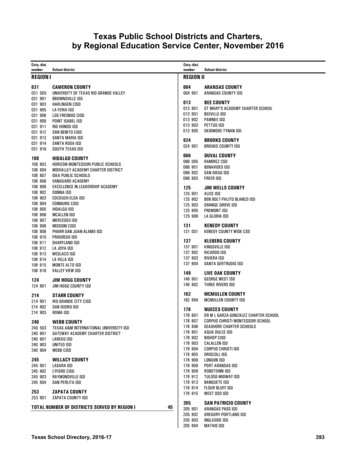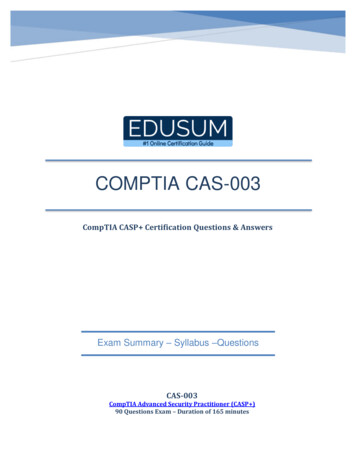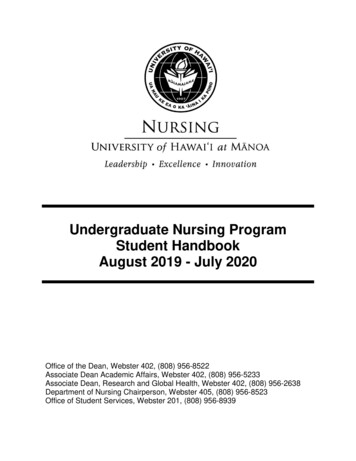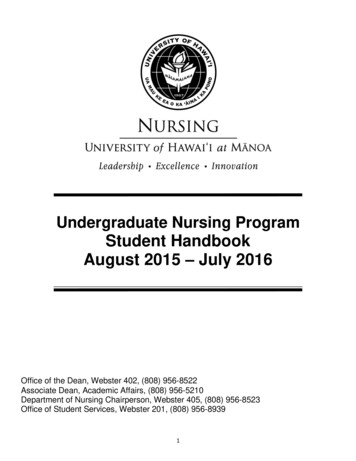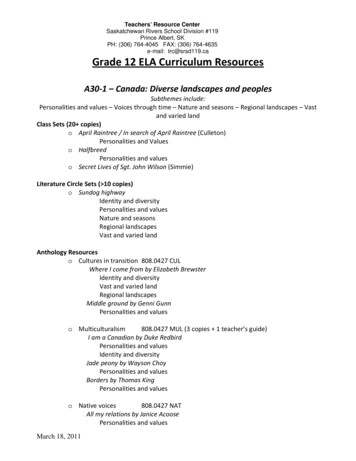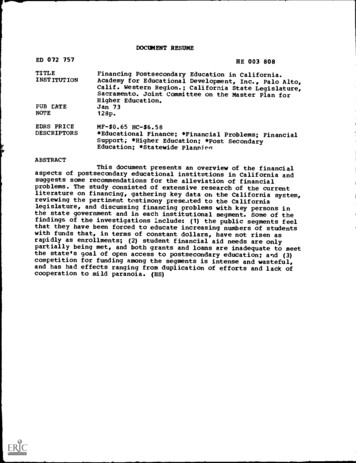
Transcription
DOCUMENT RESUMEED 072 757TITLEINSTITUTIONPUB DATENOTEEDRS PRICEDESCRIPTORSHE 003 808Financing Postsecondary Education in California.Academy for Educational Development, Inc., Palo Alto,Calif. Western Region.; California State Legislature,Sacramento. Joint Committee on the Master Plan forHigher Education.Jan 73128p.MF- 0.65 HC- 6.58*Educational Finance; *Financial Problems; FinancialSupport; *Higher Education; *Post SecondaryEducation; *Statewide PlanniraABSTRACTThis document presents an overview of the financialaspects of postsecondary educational institutions in California andsuggests some recommendations for the alleviation of financialproblems. The study consisted of extensive research of the currentliterature on financing, gathering key data on the California system,reviewing the pertinent testimony preseated to the Californialegislature, and discussing financing problems with key persons inthe state government and in each institutional segment. Some of thefindings of the investigations include: (1) the public segments feelthat they have been forced to educate increasing numbers of studentswith funds that, in terms of constant dollars, have not risen asrapidly as enrollments; (2) student financial aid needs are onlypartially being met, and both grants and loans are inadequate to meetthe state's goal of open access to postsecondary education; and (3)competition for funding among the segments is intense and wasteful,and has had effects ranging from duplication of efforts and lack ofcooperation to mild paranoia. (HS)
FINANCING posPcsecoNbARyebUCACiON IN CAUFORN1AAcAticmy FoR EOUCATiONAL tIEVELOpMENr, INC.z4OFHEALIN&WELFREU S DEPARTMENTEDUCATION EDUCAIION PEPPOOFFICE OF HAS BEEN 10MPENES) OP,THIS DOCUMEN1 AbNIZAVONExAC1Lv'3U( EDOP ORO\ VIEW Or OPIN1HE PERSON P)INIS OFNECESSAPIOiNAltNt, ;100 NO1Oi FOil511010OW P, OF FICEIONSOP P01(Pi PRESENT( Al ()N POSIlIONNM I) MRJOINT COMMITTEE ON THE MASTER PLAN roR HIGHER EDUCATIONCALI1ORNIA LEGISLATURE
FINANCING POSTSECONDARY EDUCATION IN CALIFORNIAAcademy for Educational Development, Inc.Palo Alto, CaliforniaWashington, D.C.Akron, OhioNew YorkParisPrepared for(JOINT COMMITTEE ON THE MASTER PLANFOR HIGHER EDUCATIONCaliforAia LegislatureAssembly Post Office Box 83State CapitolSacramento, California 95814AssemblymenJohn Vasconcellos(Chairman)Willie BrownJerry LewisKen MeadeJohn StullSenatorsHoward Way(Vice Chairman)Alfred AlquistDennis CarpenterMervyn DymallyAlbert RoddaPatrick M. Callan, ConsultantDaniel Friedlander, Assistant ConsultantSue Powell, Assistant ConsultantElizabeth Richter, Secretary(January, 1973
This is one of a series of policy alternative paperscommissioned by the California Legislature's Joint Committeeon ihe Master Plan for Higher Education.The primary purpose of these papers is to givelegislators an overview of a given policy area.Most ofthe papers are directed toward synthesis and analysis ofexisting information and perspectives rather than thegathering of new data.The authors were asked to raiseand explore prominent issues and to suggest policiesavailable to the Legislature in dealing with those issues.The Joint Committee has not restricted its consultantsto discussions and recommendations in those areas which fallexclusively within the scope of legislative responsibility.The authors were encouraged to direct comments to individualinstitutions, segmental offices, state agencies -- orwherever seemed appropriate.It is hoped that thesepapers will stimulate public, segmental and institutionaldiscussion of the critical issues in post-secondaryeducation.
ACADEMY FOR EDUCATIONAL DEVELOPMENT. INCa nonprofitplanning organizationJanuary, 1973The Honorable John Vasconcelios, ChairmanJoint Committee on the Master Plan forHigler EducationCalifornia LegislatureSacrallento, California95814Dear Mr. Vasconcellos:We are pleased to submit this report on financingpost-secondary education in California in fulfillment of ourcontract LCB# 12046.We were fortunate in that this study closelyparalleled a concurrent study made for the State of Washington.With the agreement of both state staffs, we were able tocombine much of the research and development of methodologiesin the two studies, to the advantage of all concerned. Thusmany parts of the text are essentially common to the twostudies.In the course of making this study, we interviewedmany persons in California state agencies and the legislativestaffs, and spokesmen for the several segments of theCalifornia system.All were cooperative and responsive, andwe owe our thanks to each person who took the time to help usidentify and clarify existing problems.Special thanks aredue to the California State Scholarship and Loan Commissionfor sharing with us the data from the Student Resources Surveywhich was conducted during the course of our study. We alsoworked closely with members of your Committee staff and wouldlike to thank them for their valuable assistance and theirpatience.We hope that this report will help to stimulateopen discussion of the alternative courses open to Californiain meeting the financing problems of the future.Sincerely,AlvinEurichPresidentRobert R. HindDirectorWestern RegionPALO ALTO OFFICE' 770 WELCH ROAD. PALL' ALTO. CALIFORNIA 94304(4151 327.2270
(TABLE OF CONTENTSREPORT SUMMARY(,.1SECTION 1: INTRODUCTION3SECTION 2: WHO BENEFITS17SECTION 3: PRICING AND STUDENT AID25SECTION 4: STUDENT LOANS37SECTION 5: CURRENT PRACTICES IN STATEFINANCING50SECTION 6: PRODUCTIVITY.SECTION 7: SOME OPTIONS FOR CALIFORNIA.6065APPENDICES:Federal HoleI.Tl2.Theoretical Issues of Cost- BenefitAnalysis3.BIBLIOGRAPHYSummary of Student Resources Survey8385.10311CA. .L. .,/
REPORT SUMMARYSECTION 1 - Increased funding will be required in the comingdecade to accommodate the demands of increasing enrollments of college age and older students. Added funds willhave to come from within the state, in the near future,since philanthropic dollars are unlikely to grow, andsubstantial increases in federal funds are several yearsoff.The state itself, and users of the system, mustcarry most of the burden.SECTION 2 - Cost-benefit analysis is of limited utility indetermiring who should pay for post-secondary education.Clearly there are societal benefits, for which societyshould pay; there are also benefits to participatingindividuals for which they might be expected to pay.Butthere is no agreement on how to strike a balance. Althoughcost-benefit analysis does not provide us with the easyanswers, it does highlight the major option open todecision-makers: determination of how much students shouldpay, with the understanding that society pays the rest.SECTION 3 - Pricing -- tuition charges and student aid -- then,can be looked upon as the major variables. Low tuitionis the traditional method of assuring wide access topost-secondary education, but the device has not workedto open opportunity equally to al]. Full cost pricing,if coupled with need-based student aid, can maximizeaccess, but might be highly disruptive for many middleincome students.SECTION 4 - Student loans provide an increasingly attractiveaid device, regardless of the selected financing pattern.California could operate a direct loan program, underwritestudent loans under a guarantee program, or adopt a program with the major features of deferred tuition plansunder which borrowers repay in proportion to their earnings after leaving college.SECTION 5 - Tue various states have adopted, or are considering,a number of different approaches to coping with theirfinancing problems. The differences seem in part toreflect variations in public-private balance, tradition,and goals.They provide a variety of models to be considered and watched.-1-
SECTION 6 - Present levels of financing oan Ise male more effeotIvoby adoptfng new technologies and methods of instruetton forselected courses, new ways to extend the campus walls, andimproved methods of management control.The state shouldprovide financial inducements for development and pilottesting of innovations directed toward improving productivity.SECTION 7 - The major financing options now open to California,if it wishes to achieve the goals of high quality, accessibility, equity, and responsiveness to state needs, include:1.Make the present system more equitable and effectivein providing wide access by directing added funds tostudent financial aid and establishing an effectivestudent loan program.2.Move to full cost pricing, with massive financial aidto needy students.3.Move part of the way toward full cost pricing, withnecessary accompanying student aid.4.Adopt a variable pricing system which reflectsdifferences in instructional costs, either by program,or by level.Selection of one or more of these options is sure to beinfluenced by the effect of 1972 federal legislation,which provides for basic grants to needy students of 1400 per year, with additional grants for disadvantagedstudents. Although the full funding that will permittop grant payments may be same years off, any progresstoward full funding is likely to push states to chargefees that will raise student costs to levels high enoughto draw the maximum federn subsidy. Such subsidies, oneway or another, will shift a part of the cost burden fromthe state to the federal government.-2-
1.INThODUCTiONTne study that led to the development of this reportbegan with the premise that virtually every institution andsystem of post-secondary education faces serious financialproblems.Caught between costs which are rising more rapidlythan the general price level, and income which is rising lessrapidly due to the competition of other demands which seem morecompelling to those who decide how money is to be spent, educational planners have been forced to seek new ways to stretchacademic dollars. It is to this task that we address ourselves.tie have not had the time or resources to make aprecise, definitive analysis and projection of financing patterns.Rather, we have taken a broad brush approach, concentrating more on the theoretical and philosophical backgroundwhich might :Annulate uninhibited debate of the alternativedirections financing might take.Since this is one of a number of special reports forthe Joint Committee, we have not attempted to make it comprehensive by elaborating in detail the existing characteristicsof the California system. We assume that the reader isfamiliar with the structure of the system, informed by thecompanion reports and by the many other studies and documentsproduced by state agencies. Suffice it to say that it is thenation's largest system, that it has grown rapidly in recentyear;, that its quality Jo high and its range broad.In orderto maintain perspective, it seems important to draw attentionto the enrollment distribution among the various segments,which were as follows, in 1971-72:FTE'University of CaliforniaState University & CollegesCommunity Colleges (ADA)Independent ent10.3%21.5%58.2%10.0%TUTTUf*Full-time equivalent enrollment, except for the CommunityColleges which report only average daily attendance (ADA).ADA and FTE are only approximately interchangeable (ADA apparently overstates full-time enrollment), leading to inaccuracyin any computation based on enrcllrnents. This discrepancy wasprobably the most exasperating we encountered. Although we-3-
Although enrollments are one Indication of the magnitude and importance of the various segments, they do notreflect the important research and service functions of highereducation, nor the greater demands of advanced scholarship.These latter functions are of course concentrated most heavilyIn the four-year institutions, and particularly in the University of California and some of the independent universities.Our study consisted of extensive research of thecurrent literature on financing, gathering key data on theCalifornio nyntem, reviewing the pertinent testiAony presentedto the Joint Committee and other state reports, and discussingftnanclne, problems with key per:lon:1 in the :state governmentand In each inhtliutIonal segment.It would be imponsible tosummarise here all the views we received, but some highlightsand interpretations are worth noting:1.The public segments feel that they have been forced toeducate increasing numbers of students with funds that, interms of constant dollars, have not risen as rapidly asenrollments.The Community Colleges, which provide more than half of thepost-secondary education, suffer from an anachronistic andinflexible funding formula that lingers from the days whenthese institutions were simply extensions of high schools.state support, which has sagged to around 30 percent ofcosts (with the rest of the burden falling on local distrIcto of unequal wealth), Is appropriated as vart of thenchool rund covering yearscertainly a neoLent ofthin magnitude :;luhave independent cons tderation bythe hegislature. The present Cormula Is statutorilyfixed in dollars whose purcha:Ong power continues todecline.Purthermore, the cumbersome A1)A formula adaptedfrom the lower schools takes no account of cost differencesamong programs, and does not reimburse counseling program; which urgently need improvement in just thosedistricts which need them most because they are servingdisproportionate numbers of educationally handicappedstudents. The community college board favors formulafunding because its objectivity of allocation helps to preserve local autonomy, but would prefer a shift towardIwere not asked to make recommendations in this study, only toreview alternatives, we feel compelled to urge that the staterequire the development of comparable and consistent data fromthe various segments.It seems ironic that at a time wheninstitutions are developing highly sophisticated analytictools for intra-institutional and intra-segmental analysisthat state-level planners must deal with incomplete information.-4-
state, rathor than local, support In keeping with thegeneral effort to relieve local tax burdens and to restoreequity to all users of public systems.4The public four-year institutions, all or which aroengaged In the develop; ent of new approaches to cope witha changing educatonal ambience and new student needs (andin this, on the basis of our observations, clearly leadthe nation), are troubled by uncertainty in financing.Year-to-year appropriations, without any long-rangecommitments on which to build long-range programs, areseriously hampering innovative efforts; even creative andimaginative people need the assurance that they can seetheir endevors through. Continued myopic appropriationsprocedures can only serve to submerge creativity in asearch for security, with a consequent loss to the moreinnovative components of the California system of theirbest people.2.Student financial aid needs are only partially being Anet.Roth grants and loans are inadequate to meet the state'sgoal of open access, to post-secondary education.The four-year Institutions are concerned that "self help"-- loans and work-study -- have become too large a proportion of the student aid framework. California's studentgrant program has been effectively managed by the StateScholarship and Loan Commission, but its total volume istrivial as compared with need and with the efforts of mostother states (see Section 7 and Table 5 on page 50a).Consistent with the generally observed pattern that lowstudent charges lead to low levels of student aid, theCommunity Colleges, which are free in California, have verysmall amounts of aid funds to disburse and some have noneat all. This shortcoming surely keeps, or drives, manycapable students out of the system.3.Competition for funding among the segments is intense andwasteful, and has had effects ranging from duplication ofefforts and lack of cooperation to mild paranoia.Some National ComparisonsDespite problems within the system, higher educationin California has done reasonably well for itself relative toother states.The quality of the system is undisputed. Thetables on the following pages show that the state is above thenational median (though not always above the average or mean)in the amounts directed toward post-secondary education andthe level of participation in the system.-5-
4Conll)arlsons Over TimeTabletrce:t the growth ()I' budgets for the publicsystems over the last few years, and demonstrates that over-all,Californians have modestly increased the proportion of publicrevenues devoted to post-secondary education, contrary to thegeneral belief that other public services have cut into education appropriations. The University of California, by contrast,has slipped in its share of state funds despite a 38 percentincrease in dollar appropriations over the last six year:.ii
de IslandCaliforniaMaineSouth ssissippiFloridaWisconsinNorth CarolinaGeorgiaKentuckyNew JerseyHawaiiPennsylvaniaIllinoisAlaskaNew 24572132 32882718 1625New Hampshire50.AlabamaMontanaUtahSouth DakotaVirginiaNebraskaNorth DakotaOklahomaTexasTennesseeOregonNew MexicoKansasMinnesotaWest sCombined State and Local Appropriations for Higher EducationPer Equivalent Full Time Student- -1970 -1971TABLE 1
8.9.2.422.30LouisianaMissouriMississippiWest wareMichigcn3.313.173.153.153.062.942.842.83New PercentEnrol ledWisconsinIdahoSouth oradoUtahHawaiiWyomingOregon3.4.5.6.North New JerseyGeorgiaConnecticutMaineNew YorkSouth CarolinaKentuckyNew HampshireAlaskaArkansasVirginiaTennesseeNorth a29.30.31.32.33.34.35.36.2E.VermontMarylandRhode Island26.27.StatePercentage of Student Enrollment in Public InstitutionsTo Total Popu I ation -- 1970-1971TABLE 9PercentEnrolled
21.22.23.24.25. 11.34West VirginiaAverageOklahoma42.43.44.IowaMarylandNew irginia41.13.6513.5913.1012.8411.94New tahNorth 3.8113.70ArizonaHawaiiNorth DakotaNew tNew JerseyRhode IslandOhioMissouriDelawareArkansasSouth CarolinaVermontTennesseeIndianaFloridaSouth 4.35.36.37.38.39.40.MinnesotaState .6.2.3.4.1.StatePer 1000IncomeAppropriationsCombined State and Local Appropriations for Higher EducationPer 1000 of Per Capita Personal Income- -1970 -1971TABLE 010.0810.02Per S1000IncomeAppropriations
%5 4%5.5%5.3%5.9%ve. of TotalExpended o U of %4.1%Expended for State U & CAmount% of Total(232)222 (588)184 (526)163 (451)127 (377)105 (319)82 (250)713.1% (7.7%)2.8% (7.7%)2.6% (6.9%)2.1% (6.0%)2.0% (5.8%)1.8% (5.2%)1.7% (5.4%)Expended for C.C.'s (1)Amount% of TotalSTATE BUDGET EXPENDITURES FOR HIGHER EDUCATION(Millions of dollars)Data from budget reports of the Legislative Analyst(1) The amounts in parenthesis are totals of state and local funds. Percent figures in parenthesis represent the proportions of thestate's total budget expenditures plus local community college expenditures.(2) Institutional total only. Excludes state scholarships, sTotal State1966-67Table 4908 (1274)826 (1168)805 (1093)745 (995)633 (847)526 (694)482 (643)Amount(1) (2)(14 3%)127%k)12 .-% (17.1%)13 0'4 (15.8%)12 3% (15.7%)12.0 (15.5%)11 3".1.11.6% (14.9%)V-. of T,31Total Public Sege-.
SOURCES - FOR TABLES 1-4TABLE 11.Chambers, M.M., "Appropriations of State Tax Funds forOperating Expenses of Higher Education, 1970-71",Office of Institutional Research, National Associationof Land Grant Colleges, One Dupont Circle, N.W., Washington, D.C.2.U.S. Department of Commerce, "Governmental Finances in1969-70", September 1971.3.U.S. Department of Commerce, "Governmental Finances in970 ", July 1971.4.U.S. Department of Health, Education and Welfare,"Opening Fall Enrollment in Higher Education, 1970, 14.!port on Preliminary Survey", USOE No. 54003-68, 1969.TABLE 21.U.S. Department of Health, Education and Welfare,"Opening Fall Enrollment in Higher Education, 1970,Report on Preliminary Survey", USOE No. 54003-68, 1969.2.U.S. Department of Commerce, "Population Estimates andProjections", Series P-25, No. 468, October 5, 1971.TABLE 31.Chambers, M.M., "Appropriations of State Tax Funds forOperating Expenses of Higher Education, 1970-71",Office of Institutional Research, National Associationof Land Grant Colleges, One Dupont Circle, N.W., Washington, D.C.2.U.S. Department of Commerce, "Governmental Finances in1969-70", September 1971.3.U.S. Department of Commerce, "Governmental Finances in1970", July 1971.4.U.S. Department of Commerce, "Population Estimates andProjections", Series P-25, No. 468, October 5, 1971.5.U.S. Department of Commerce, "Survey of Current Business", August 1971.TABLE 41.Budget Reports of the Legislative Analyst.
The Demands of the FutureWe have not made a detailed analysis of the variousstate and national enrollment projections which have beenmade In recent years.In general, though, forecasts callfor a slow rate of Increase among students of traditionalcollege age In the coming decades.On the other hand, it islikely that the demand for post-secondary education amongpersons beyond college age will increase. Demands for upgrading of skills and adaptation to a rapidly changingtechnology will surely increase the numbers of older personscoming into the system for everything from short courses todegree programs.The final major factor is the influence of policiesand programs instituted by the state and the system as theymove toward fulfilling the goals of access and equity.Ifaid and recruitment programs are expanded, naturally we cananticipate enrollment increases.The number and complexity of these variables makesforecasting risky.Yet they indicate that new and enlargedprograms wl1I place increased demands on the state's financial resources.Fund DemandsOperating funds will have to be increased at roughlythe rate of enrollment growth, plus a factor for risingcosts; some economies in operation might be made, as wediscuss further below, to offset rising operating costs.In the area of capital costs, we anticipate that theneed will be somewhat below the rates of expenditure inrecent years. Major needs will be for construction on newlyestablished campuses, to remedy some imbalances, and to provide new or replacement facilities for fields undergoingrapid change or expansion.Serving the needs of more adultand part-time students may call for new kinds of facilitiesin different kinds of locations.Offsets to increases in capital needs may be foundin at least three ways. First, policies aimed at increasingenrollnents in unfilled independent colleges and universitiescan reduce the need for added space in state institutions.Secondly, leased or improvised facilities could be substituted for regular campus construction in many areas.Andthird, if a significant portion of the emiollment increaseoccurs among adult students who are best served by weekendand evening courses, the rate of utilization of present-12-
I,facilities can be increased, obviating the need for much newconstruction.In summary, post-secondary education will requireincreased funding In the coming decade as it expands itsrange of services.The rate of increase will not be asgreat as that of the sixties, since the enrollment boom hasslowed, '-ut It will be substantial.Our next step is toexplore the sources of money for higher education in a searchfor the best ways to meet present and future needs.Sources of FundingPost-secondary education draws its current supportfrom only a few drincipal sources:the users of its services,state and local governments, the federal government, andphilanthropy. Charges to users are subject to both economiclimitations and philosophic views, and these will be discussed more fully below.The contributions of federal andphilanthropic sources are beyond the control of the stategovernment, which thus has residual responsibility for thecare and feeding of the system.Yet when the state feels apinch in providing support for institutions, there is atemptation to look to these external sources for relief.(New federal higher education legislation promises asubstantial increase in support for post-secondary education.Its full implementation will produce major changes in financing patterns which must be taken into account in state planning.But it is unlikely that its full effect will be feltfor several years.The time lapse between authorization ofprograms and major funding can be considerable.Until 1974or 1975, the states will probably have to depend upon othersources, with added help only in such acute problem areas asinstructional programs in the health services and occupationaleducation, and in student aid. New student aid provisionswill fundamentally affect financing patterns as they arefunded, and this matter is discussed further in later sections.We can lay to rest as well the likelihood of majorhelp from national foundations, except for limited innovativeprograms.California's private institutions, in particular,have received important support from individual, business,and foundation philanthropy, and this flow of resources mustbe encouraged.It should continue to grow at a modest rate,tempered by fluctuations in the economy. For the publicinstitutions, the national foundations can be a source ofshort-term support for creative ideas in instruction andstudent support. But from the standpoint of state budgetplanners, philanthropy is not likely to be an importantsource of increased support.(-13-
Thus It seems apparent that, at least for the nextfew years, the solution to financial problems will gave tobe sought, within the state's bwders, and if present patternsare continued, the bulk of the burden will fall upon thestate itself.Users of the system constitute another potentialsource of increased revenues. There are basically two typesof users:students, who obtain formal instructional services;and others who receive a wide range of services including suchdiverse activities as basic and applied research, studies,consultation, data accumulation and analysis, and entertainment.Systematic data on policies and practices in thesepublic service areas are not now available, but it appearslikely that full cost is not being charged for all such services.Careful analysis of costs, and adoption of a fullpricing policy seems legitimate and fair, and could generatesome additional operating revenues.New data on students' ability to pay, as well assupport needs for those less able to pay, has recently becomeavailable through a Student Resources Survey conducted by theCollege Entrance Examination Board in tandem with this study offinancing. Appendix 3 consists of a summary of the studyresults excerpted from the report.The study tells us someremarkable things about the tenacity and resourcefulness ofstudents who want to get ar education. Although there is asignificant aid gap, as discussed in Section 7, and the evidence that parental contributions to the cost of theirchildren's education falls below expectations, underfundedstudents do stay in the system. Despite this persistence, the,shortage of aid funds must be remedied if universal access isto be achieved.Purthermore, this survey tells us nothingabout those persons who were not, surveyed:those who neverentePod tho system because or their inability, or at least theirperceived Inabillty, to continue their education beyond thesecondary level.Examination of the other end of the scale suggests thatmany students could pay more for their education. The reciprocal of the above deficit observation tells us that many studentswho could afford to pay more are enrolled in California's lowcost institutions. With 17.3* percent of community collegestudents and over 35* percent of public four-year institutionstudents coming from families with incomes of over 18,000 peryear, according to the SRS analysis, there would appear to beuntapped ability to pay.* As reported by respondents to the SHS survey.-14-
Any increase in student payments would have to beaccompanied by increased aid for those already below, orwho would drop below, the deficit point. Loans would alsohelp to cushion the shock for all.The Major OptionsFinding solutions to the state's post-secondary education financing problems is not a simple matter. Everyonehas a stake in the system, and solutions will be found onlyif all who are directly concerned work at it -- state officials,administrative officers, faculty, and students as well.The solutions will De found among relatively fewoption
TITLE Financing Postsecondary Education in California. INSTITUTION Academy for Educational Development, Inc., Palo Alto, Calif. Western Region.; California State Legislature, Sacramento. Joint Committee on the Master Plan for. Higher Education. PUB DATE Jan 73 NOTE. 128p. EDRS PRICE MF- 0.65 HC- 6.58
